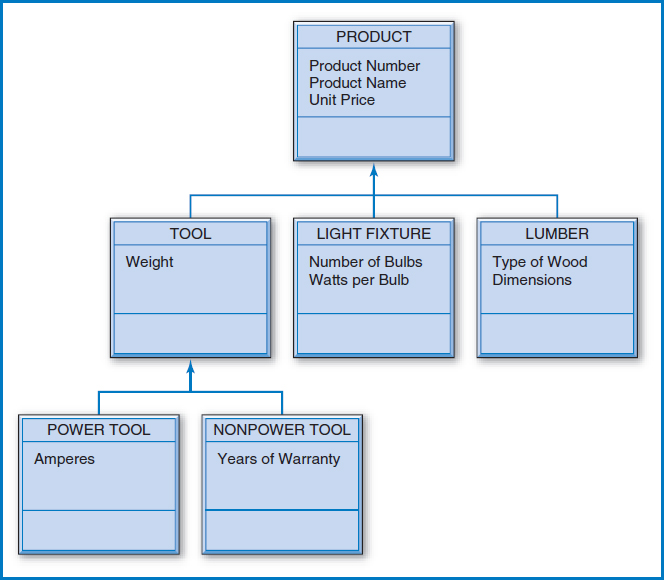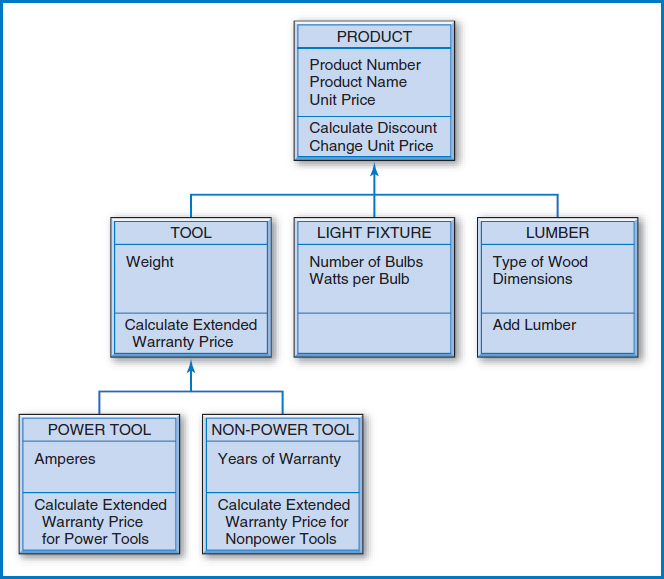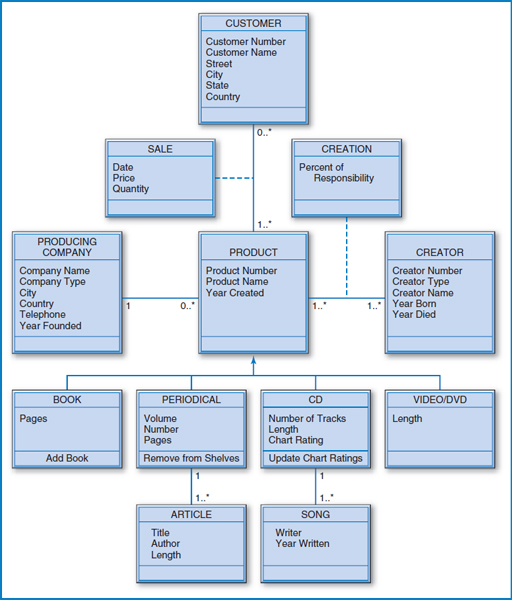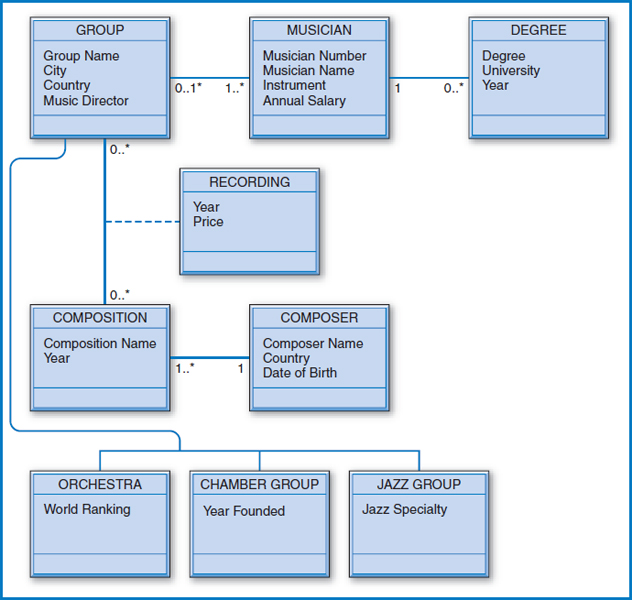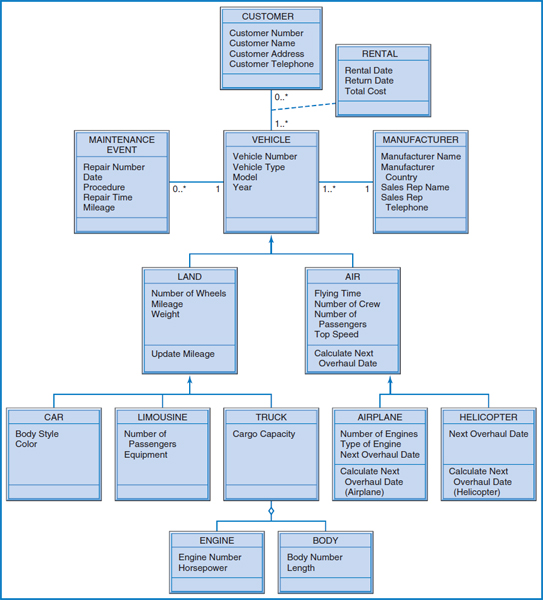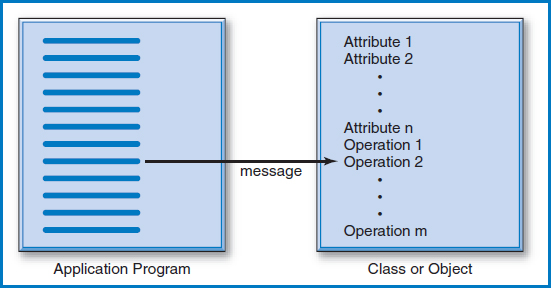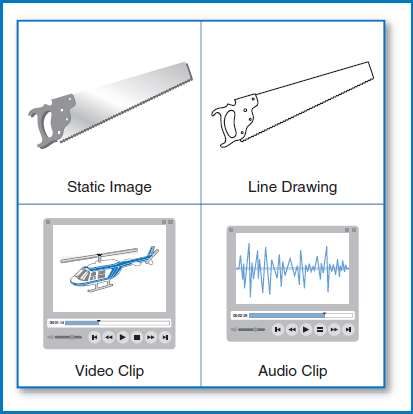CHAPTER 9
OBJECT-ORIENTED DATABASE MANAGEMENT
Traditional information systems and the applications within them have always maintained a clear separation between their programs and their data. Programs and data structures are designed separately, implemented separately, and stored separately on disk. Relational databases fit very well into this arrangement. For a long time the emphasis was on the programs, with the data structures and ultimately the data stored in them being a secondary consideration. From a managerial point of view, the concept of data as a corporate resource has made significant inroads into changing the IS environment from this program-centric mentality into a more datacentric one.
On the technical side, an alternative approach to information systems and IS development, which comes under the broad heading of “object orientation,” began during the 1980s. This approach is, by its nature, more datacentric. It began with object-oriented programming, then object-oriented systems analysis and object-oriented systems design, and finally object-oriented database management, complete with object-oriented database management systems (OODBMS). A variety of OODBMSs have been developed and marketed commercially. We will take a brief look at the essential points of object-oriented database management in this chapter, but, as we do, it is important to bear in mind that the commercial OODBMSs vary widely in the OODBMS features that they support either partially or fully.
OBJECTIVES
- List several limitations in the relational database model.
- Describe the object-oriented database concept.
- Model data using such complex relationships as generalization and aggregation, and such concepts as inheritance and polymorphism.
- Describe the benefits of encapsulation.
- Describe the value of developing abstract data types.
- Explain what an object/relational database is.
CHAPTER OUTLINE
Terminology
Complex Relationships
- Generalization
- Inheritance of Attributes
- Operations, Inheritance of Operations, and Polymorphism
- Aggregation
- The General Hardware Co. Class Diagram
- The Good Reading Bookstores Class Diagram
- The World Music Association Class Diagram
- The Lucky Rent-A-Vehicle Class Diagram
Encapsulation
Abstract Data Types
Object/Relational Database
Summary
INTRODUCTION
Relational tables certainly seem to do a good job of storing data for information systems, as we've seen in concept and in a variety of examples. So, what's missing? The answer to this question is a bit complicated. Many people would say that nothing is missing from the relational model (or, for that matter, in this context, from the hierarchical and network models that came before it)! Others would point out that for certain kinds of complex applications, the relational model lacks support for the more complex data model features they need. There is even an argument that all, applications could benefit from certain additional features in terms of data integrity.
Let's take a look at “what's missing” from the relational model. The answer to this question will also serve as an introduction to the main features of the object-oriented database model.
- While the relational model is fine for dealing with unary, binary, and ternary relationships among entities, it does not directly provide support for more complex but important relationships among different subcategories or specialized categories of particular entities. This is known as “generalization” or “generalization/specialization” in the object-oriented database model. Nor does the relational model directly provide support for situations in which particular entities are constructed from other component entities. This is known as “aggregation” in the object-oriented database model.
- As in all traditional information systems, the separation of programs and databases exposes the data in the databases to being updated by a variety of programs. Of course, we assume that these programs are thoroughly tested and debugged. But with many people writing programs that can affect particular data, there is always the question whether a hidden mistake can pop up unexpectedly and cause errors in the data. This becomes even more serious as the sharing of data among different applications increases. What might be desirable is to have a system in which only a limited, controlled set of program segments is allowed to update particular data. Application programs would then make requests for the execution of these program segments to update the data. This could go a long way towards improving the integrity of the data.
- The relational model supports only a limited number of relatively simplistic numeric and character-oriented data types. These are sufficient for most standard accounting, inventory, and other traditional business applications. But this model does not directly support the more complex data types that we increasingly encounter such as graphic images, photo images, video clips, audio clips, long text documents, and such mathematical constructs as matrices. The object-oriented database model, with its “abstract data type” feature, allows the creation of all these data types and any others that are needed.
There are several other features or advantages of the object-oriented database concept. One is that each unit of data or “object” has an object identifier that is permanent and unique among all objects of all types in the system. Another is that some OODBMSs are implemented as pointer-based systems, meaning that related objects are “connected” by their storage addresses, as opposed to the foreign key/join arrangement in relational databases. Arguments have been made that this pointer-based approach provides better performance than the multi-table join approach of relational databases when related data must be brought together. (Ironically, relational databases replaced the pointer-based approach of the earlier hierarchical and network DBMSs). Finally, it is argued that OODBMSs are the most natural data storage vehicles when using object-oriented programming languages, such as C++, Smalltalk, and Java.
CONCEPTS IN ACTION
9-A HNEDAK BOBO GROUP
Hnedak Bobo Group (HBG) is a leading architecture and design firm headquartered in Memphis, TN, with a satellite office in Las Vegas, NV. The firm has 28 registered architects and 43 licensed professionals. HBG is organized into architecture, interior design, and construction management divisions, with three distinct specialty practice areas focused on the entertainment and hospitality industry, corporate buildings, and urban/historic/civic structures. Hnedak (pronounced ‘knee dak’) Bobo is best known for its work in the gaming and hospitality industries and has been consistently ranked as one of the top firms in the United States for hospitality design (ranked second in national survey of hotel and hospitality design firms by Hotel & Motel Management Magazine). As for urban/historic/civic structures, Hnedak Bobo was responsible for the Peabody Place mixed-use project in Memphis, TN, which when constructed was the largest urban redevelopment project in the United States.
Hnedak Bobo Group uses a relational database application called the Contact Management and Lead Tracking System to keep track of its customers, potential customers, and potential projects or “leads.” This is a critical system in this type of large project-oriented business and requires that an owner or principal of the firm be assigned as each potential project's “pursuit manager.” The system tracks all phases of “lead development,” starting with first hearing of a possible project. It then continues with estimating the project's potential for the firm, estimating the probability of getting the contract, and, eventually, to contract negotiation and signing. An important part of this ongoing effort is keeping in touch with the firm's customers and potential customers. To this end, the system maintains personal information about these people and is organized to maintain contact with them through greeting cards, gifts, a newsletter, and company announcements.
Hnedak Bobo's Contact Management and Lead Tracking System is stored as an MS Access relational database running on a Compaq server It employs canned, menu-based queries written in Visual Basic. The main database tables are a Contacts table with 5,500 records (meaning that HBG maintains contact with that many people) and an Events table that tracks every meeting, telephone call, etc. with each contact. Another set of tables tracks the project leads and lead development phases.
“Photo Courtesy of Hnedak Bobo Group”
TERMINOLOGY
Earlier we defined an entity as an object or event in our environment that we want to keep track of. An entity set was defined as a collection of entities of the same type. Entities have properties that we called attributes. We then defined a data structure known as a record that contains all of the facts (the attributes) that we know about a given entity. The records about all of the entities in an entity set were collected together in a file. Finally, we spoke of a record type as a general description of all of the records in a file, essentially a list of the kinds of attributes that describe each of the entities. And we spoke of a record occurrence as a specific set of attribute values that describe one of the entities.
Object-oriented data modeling has its own features and its own terminology, but it still must describe the entities, the objects, and events in the real business environment. Having said that, the first point to recognize is that in object-oriented modeling, the term object is used to describe an advanced data structure that includes an entity's attributes plus methods or operations or procedures (program code!) that can operate on and modify the object's attribute values. This is obviously a major departure from the strict separation of data and program code that we're used to. In the same spirit in which we organized the records that described similar entities into a file, the objects that describe similar entities are known collectively as an object class or, simply, a class. Conversely, an instance or an occurrence of a class is an object.
This terminology is in keeping with the standard diagramming notation for object-oriented systems development known as the Unified Modeling Language (UML). Introduced in 1997 by the Object Management Group (OMG), UML has nine standard diagrams that describe such features as the system's data, its business processes, its intended results, the components of its program code, and its hardware and software architectures. For our purposes, we will focus on the UML Class Diagram, which describes the system's data, including attributes of and relationships among the “objects.” As before, we will demonstrate these OODBMS concepts in the context of the General Hardware Co. example, as well as the other three running examples we have used. Some of the details of the examples will have to be changed in order to demonstrate the object-oriented concepts and we will point out those changes carefully as they occur.
COMPLEX RELATIONSHIPS
In our earlier discussion of data modeling using the entity-relationship model that led to relational database design, we saw the importance of being able to model unary, binary, and ternary one-to-one, one-to-many, and many-to-many relationships. The first question, then, is: can we model such relationships in UML class diagrams and can they be implemented in the OODBMS concept? The answer is definitely yes. It had better be yes because, as we know by now, those are fundamental relationships in any business environment. The point, however, is that UML class diagrams and ultimately OODBMS implementations go beyond those fundamental relationships to other more specifically targeted kinds of relationships known as generalization and aggregation.
Generalization
Generalization, also known as “generalization/specialization,” is a relationship that recognizes that some kinds of entities can be subdivided into smaller, more specialized groups. All of the entities may have some common characteristics but each of the smaller groups may have certain unique characteristics, as well. For example, all movies have a producer and a director, but only animated movies have animation artists. All boats have hulls, owners, and registration numbers, but only sailboats have sails. All retail stores have names, addresses, and occupancy licenses, but only restaurants have health inspection scores and restaurant critic ratings; only gas stations have underground storage tanks; only supermarkets have produce departments and meat departments.
The General Hardware Co. entity-relationship diagram of Figure 2.9 is reproduced here as Figure 9.1. Remember that General Hardware is a wholesaler that supplies retail stores such as hardware stores, home improvement chains, etc. Thus far, the only products that we've assumed General Hardware sells its customers are tools. But now, General Hardware has decided to expand its product line beyond tools to include light fixtures and lumber. Figure 9.2 shows a generalization diagram that represents General Hardware's expanded product line and recognizes that while all of the products share some common attributes, different kinds of products have additional unique attributes. Each box in Figure 9.2 represents a class and has three sections separated by horizontal lines. At the top, in capital letters, is the class name. In the middle are the class attributes. At the bottom are the class operations (although we're not showing any operations yet). The upward-pointing arrows indicate generalizations. The diagram shows that there are three kinds of products: TOOLs, LIGHT FIXTUREs, and LUMBER. Furthermore, there are two kinds of tools: POWER TOOLs and NON-POWER TOOLs.
FIGURE 9.1 The General Hardware Company E-R diagram
FIGURE 9.2 General Hardware Company product generalization diagram
Inheritance of Attributes
The PRODUCT class indicates that all products have three common attributes: Product Number, Product Name, and Unit Price. In fact, we say that all of the classes below PRODUCT inherit the attributes shown in PRODUCT; that is, they include these attributes among their own. In general, attributes are inherited downwards in these generalization diagrams. So,
- the attributes for POWER TOOLs are Product Number, Product Name, Unit Price (all from PRODUCT), Weight (from TOOL), and Amperes.
- the attributes for NON-POWER TOOLs are Product Number, Product Name, Unit Price, Weight, and Years of Warranty.
- the attributes for LIGHT FIXTUREs are Product Number, Product Name, Unit Price, Number of Bulbs, and Watts Per Bulb.
- the attributes for LUMBER are Product Number, Product Name, Unit Price, Type of Wood, and Dimensions.
Operations, Inheritance of Operations, and Polymorphism
Figure 9.3 shows the addition of some operations to the diagram in Figure 9.2. Actually, there are three kinds of operations: constructor, query, and update. A constructor operation creates a new instance of a class, i.e. a new object. An example in Figure 9.3 is Add Lumber, which is an operation that will add a new instance of LUMBER, i.e. a new object, to the database when General Hardware starts carrying a new type or size of lumber in its wholesale inventory. A query operation returns data about the values of an object's attributes but does not update them. Calculate Discount in the PRODUCT class is an example of a query operation. The operation calculates a discount for a particular customer buying a particular product and returns the result to the user who issued the query, but does not store the result in the database. An update operation updates an object's attribute values. Change Unit Price in the PRODUCT class is an example of an update operation. From time to time a product's unit price has to be changed and the result stored in the database as the new unit price.
FIGURE 9.3 General Hardware Company product generalization diagram with operations
Notice that Calculate Discount is an operation that applies to all products because operations are inherited downwards in the same way that attributes are. In fact, since there is nothing more said about the discount further down the hierarchy, we conclude that the discount is calculated in the same way for all kinds of products. On the other hand, the diagram indicates that the Calculate Extended Warranty Price for TOOLs is performed differently for POWER TOOLs and for NON-POWER TOOLs. The operation is initially specified in the TOOLs box but operation names in the POWER TOOL and NON-POWER TOOL boxes indicate that it changes in some way when it is inherited down to those boxes. Perhaps the presence of an electric motor in the power tools requires a different kind of calculation. This modification or refinement of operations as they are inherited downwards is called polymorphism. (Note: technically, the operations that are performed differently in the lower-level objects can have the same name—simply Calculate Extended Warranty Price in this example—even though they will perform differently for the different kinds of objects.)
Aggregation
Figure 9.4 shows the addition of the FRAME and BULBS classes, connected to the LIGHT FIXTURE class with a diamond-shaped symbol. This is not further generalization but is another type of relationship known as aggregation. In generalization, lower-level classes are kinds of upper-level classes (e.g. POWER TOOLs and NON-POWER TOOLs are both kinds of TOOLs). In aggregation, a class is shown to be composed of other classes. FRAMEs and BULBS are not kinds of LIGHT FIXTUREs; rather, each is a part of a LIGHT FIXTURE. As shown in Figure 9.4, the component classes can each have their own special attributes and conceivably, operations, too.
FIGURE 9.4 General Hardware Company product diagram with aggregation
The General Hardware Co. Class Diagram
Figure 9.5 shows the complete General Hardware Co. UML Class Diagram. The upper portion of the diagram is largely the same as the entity-relationship diagram of Figure 9.1. In converting the entity boxes to class boxes we added some operations and changed some of the notation. In terms of one-to-one, one-to-many, and many-to-many relationships, in this notation “1” means exactly one, “0..1” means zero or one, “0..*” means zero-to-many, and “1..*” means one-to-many. Also note that the many-to-many relationship between SALESPERSON and PRODUCT requires an additional class (similar in concept to an associative entity) to show the nature of the many-to-many relationship, including any intersection data. This SALE class is attached to the connective line between the SALESPERSON and PRODUCT classes with a dashed line.
It is important to stop here for a moment and ask whether an ordinary relational database together with application programming could be used to implement all the various kinds of relationships in Figure 9.5. The answer is yes, it could. But the point is that it would be up to the database designer and especially the application programmer to manage the various kinds of relationships in the database with the application code. This is different from an OODBMS, which is designed to handle all of these relationships among its natural features. To stretch a term a bit, in the OODBMS concept, the database management system “understands” all these kinds of relationships and is capable of directly managing the data involved in them.
The Good Reading Bookstores Class Diagram
Good Reading Bookstores has decided to expand its product line to include periodicals (newspapers and magazines), music CDs, and movie videos/DVDs. The upper portion of Figure 9.6 is the class-diagram version of the entity-relationship diagram of Figure 2.10, except that several changes have been made to reflect the change in product line. The BOOK entity type has become the PRODUCT class since there can now be several kinds of products, not just books. Similarly, PUBLISHER has become PRODUCING COMPANY to reflect that we are now dealing with publishers, music studios, and movie studios, and AUTHOR has become CREATOR to reflect that we are now dealing with authors, singers, and movie producers and directors.
A generalization hierarchy has been created under PRODUCT indicating that there are four kinds of products: BOOK, PERIODICAL, CD, and VIDEO/DVD. The three attributes in the PRODUCT class, Product Number, Product Name, and Year Created, are inherited downwards to all four of the subordinate classes. In addition, a book has a number of pages, a periodical has a volume, a number, and a number of pages, a CD has a number of tracks, a total length in minutes, and a chart rating (the current popularity of the CD), and a video/DVD has a length in minutes. The BOOK class has a constructor-type operation, Add Book, that adds new BOOK instances, i.e. BOOK objects, as new books are published and added to the store's inventory. PERIODICAL has a query-type operation associated with it that calculates the date when each periodical is to be removed from the store shelves if it has not been purchased by then. CD has an update-type operation associated with it that changes the value of a CD's Chart Rating attribute on a weekly basis as new industry-wide popularity charts come out.
FIGURE 9.5 General Hardware Company class diagram
FIGURE 9.6 Good Reading Bookstores class diagram
Notice that the PERIODICAL class, and only this class, is associated with the ARTICLE class. Similarly, the CD class, and only this class, is associated with the SONG class. These are reasonable restrictions since only periodicals have articles and only CDs have songs. But, this suggests an interesting point about generalization that we have not seen before. Thus far, the reason for setting up subordinate classes in a generalization hierarchy was to allow the subordinate classes to have distinct attributes and operations that the other subordinate classes don't have. Now, we see that there is a second reason for setting up subordinate classes: to be able to associate only selected subordinate classes with other classes!
The World Music Association Class Diagram
The upper portion of Figure 9.7 is the class diagram version of the World Music Association entity-relationship diagram of Figure 2.11, with one major change. Instead of considering only symphonies, which were associated with orchestras, we are going to consider many kinds of compositions. Of course, different kinds of compositions are performed by different kinds of musical groups. So, the ORCHESTRA entity type in the E-R diagram of Figure 2.11 has become the GROUP class and a generalization hierarchy has been constructed with subordinate classes ORCHESTRA, CHAMBER GROUP, and JAZZ GROUP.
FIGURE 9.7 World Music Association class diagram
The Lucky Rent-A-Vehicle Class Diagram
Lucky Rent-A-Car has expanded to become Lucky Rent-A-Vehicle! In addition to renting cars, Lucky is now renting limousines, trucks, airplanes, and helicopters. The upper part of the Lucky class diagram of Figure 9.8 looks very much like the Lucky entity-relationship diagram of Figure 2.12. The only difference is the change from the CAR entity-type to the VEHICLE class.
There is a two-level generalization hierarchy under VEHICLE. At the first level are the LAND (vehicle) and AIR (vehicle) classes. Then, at the next level down, a LAND vehicle can be a CAR, LIMOUSINE, or TRUCK, while an AIR vehicle can be an AIRPLANE or a HELICOPTER. Each CAR object will have nine attributes: Body Style and Color, plus four attributes inherited from VEHICLE and another three attributes inherited from LAND. Similarly, each LIMOUSINE will have nine attributes, each TRUCK will have eight attributes, each AIRPLANE will have eleven attributes, and each HELICOPTER will have nine attributes.
There is an update operation for all LAND vehicles to update their mileage attribute that is calculated in the same way for all three types of LAND vehicles; i.e., there is no polymorphism associated with this operation. On the other hand, the diagram indicates that there is polymorphism in the way that the Calculate Next Overhaul Date is inherited downwards from the AIR class to the AIRPLANE and HELICOPTER classes. The operation will be somewhat different for each of those two classes.
The diamond-shaped symbol on the branch under the TRUCK class indicates that there is an aggregation diagram under it. Indeed, each TRUCK is composed of an ENGINE and a BODY, each with its own attributes. Notice that the company is interested in keeping data about engines and bodies for trucks but not for cars or limos.
ENCAPSULATION
Earlier, we introduced the concept that it might, in general, be a good idea to permit particular data to be updated only by a limited, controlled set of program segments. This would have the advantage of improving data integrity by eliminating the possibility of some less-than-fully-debugged or otherwise rogue program updating the data in some inaccurate way. But how can such a concept be implemented?
YOUR TURN
9.1 GENERALIZATION/SPECIALIZATION AND AGGREGATION
Many objects in the world can be broken down into subordinate categories, i.e. “specialized,” or, in the opposite direction, “generalized.” Other objects can be created from component parts, i.e. “aggregated.”
QUESTION:
Develop a generalization/specialization diagram for objects in your university environment or another business environment of your choice. Develop an aggregation diagram for objects in the same business environment. Can you combine the two diagrams into one in a way that makes sense?
FIGURE 9.8 Lucky Rent-A-Car Vehicle class diagram
FIGURE 9.9 An application program sends a message that triggers an encapsulated operation in an object
A fascinating feature of object-oriented database management that implements these ideas is called encapsulation. In encapsulation, as illustrated in Figure 9.9, the attributes of a class' or even an individual object are “encapsulated,” stored together on the disk, with the operations that will act upon them. Yes, the program segments are actually stored within the database, which is a radical departure from the complete separation of data and programs that we always assumed in the relational database environment (as well as in the earlier navigational database environment). Furthermore, the OODBMS will permit the attributes of the encapsulated objects to be updated only by the encapsulated update-type operations. New class instances or objects will be permitted to be created only by the class's encapsulated constructor-type operations. Query-type operations would also be encapsulated but since they do not update data, the data integrity issue is not a factor.
When an application program requires encapsulated data for any reason, it sends a message to one of the object's encapsulated operations to trigger it into action, Figure 9.9. The application program sends along any input data needed for the operation (for example, the number of years that an extended warranty is to be in effect for the Calculate Extended Warranty Price for Power Tools operation in General Hardware's POWER TOOL class in Figure 9.5). The encapsulated operation then executes its program code. Depending on the type of operation, it updates the object's attribute values, adds a new instance of a class or object, or simply returns data to satisfy a query.
ABSTRACT DATA TYPES
Data has traditionally fitted into one of a small number of simple data types consisting of a few variations of character and numeric data. These are adequate to handle the kinds of attributes that we usually think of as being stored in a database. Names, addresses, descriptions, and so forth are stored as character data types. Attributes involving money and other numeric data that includes fractional amounts are stored as decimal numbers. Serial numbers or quantity attributes that count a number of items are stored as integers. Furthermore, these simple data types have operations associated with them in the programming languages that use them. We take it for granted that we can add, subtract, multiply, and divide data stored in the numeric data types, but these operations are indeed associated with numeric data types and they are specifically not associated with character-type data.
FIGURE 9.10 Abstract data types
Another of the interesting features of object-oriented database management is the ability to create new, abstract data types and operations that are associated with them. But what kinds of data might require these new and perhaps exotic data types? Figure 9.10 illustrates some of them. In today's increasingly rich data environments, we may want to store static images, line drawings, video clips, and audio clips. For example, consider adding an attribute called “Picture,” to the TOOL class of General Hardware's class diagram in Figure 9.5, so that one of the attributes of each tool is a photo of it. (This particular data type has been called a “binary large object” or “BLOB”). Associated operations might include zoom and rotate. Consider adding an attribute called “Flight” to the HELICOPTER class of Lucky Rent-A-Vehicle's class diagram in Figure 9.8 in order to include a video clip of each helicopter flying. Associated operations might include pause or fast-forward. Or consider adding an attribute called “Music” to the CD class of Good Reading Bookstore's class diagram in Figure 9.6 to include an audio clip of one of a CD's songs. An associated operation might be adjust volume. It is worth emphasizing that part of the beauty of this concept is that the attributes that use these new data types are treated exactly like the less exotic attributes that merely use the simple character, decimal, and integer data types.
OBJECT/RELATIONAL DATABASE
When OODBMSs first became commercially available in the 1980s, they found some limited use in niche applications like storing an electric power company's power grid in a data format that could take advantage of the unique features of the object-oriented data approach. But, as we know by now, these OODBMSs didn't overwhelm relational databases and displace them. For, in spite of their new bells and whistles, the OODBMSs were lacking in several areas, including the superior SQL query capabilities that everyone had become accustomed to with relational databases. Yet their advanced features were too tempting to ignore.
FIGURE 9.11 The TOOL table in an object/relational database
Eventually, perhaps inevitably, relational databases and object-oriented databases came together in the form of hybrid relational database management systems with added object-oriented features. At first, these were called “extended relational” database systems, but as they became more formalized they became known as “object/relational” database systems. Imagine the General Hardware Co. data stored as an object/relational database. A data structure for storing data about tools would essentially be a relational table that would include columns for Product Number, Product Name, Unit Price, Weight, and Photo (a photo of the tool), which would be stored as a static image-type of attribute, Figure 9.11. The attribute Photo could then appear in SQL statements just like the other attributes and could be processed as such, returning the photo to the user in a query or even matching a photo against the photos already in the table.
SUMMARY
The relational database model is certainly powerful and has proven to be highly resilient as the standard for data storage and retrieval. However, for certain kinds of complex applications, the relational model is lacking in support for certain useful data model features. The object-oriented model fills this gap. The object-oriented model provides support for more complex but important relationships among different subcategories or specialized categories of particular entities. This is known as “generalization” or “generalization/specialization.” It also supports situations in which particular entities are constructed from other component entities, known as “aggregation.” Further, the object-oriented database model with its “abstract data type” feature supports graphic images, photo images, video clips, audio clips, long text documents, and such mathematical constructs as matrices. The object-oriented model also supports “encapsulation,” in which a controlled set of program segments is stored with the data and is the only code allowed to update that particular data. Today, object-oriented database management systems have largely given way to the incorporation of these object-oriented features rated into mainstream relational database management systems.
KEY TERMS
Abstract data type
Aggregation
Class
Class diagram
Complex relationships
Encapsulation
Generalization/specialization
Inheritance
Message
Method
Object
Object class
Object-oriented data modeling
Object-oriented database
Object/relational database
Operation
Polymorphism
Procedure
Unified Modeling Language (UML)
QUESTIONS
- Name and briefly describe three deficiencies in the relational database model.
- In object-oriented terminology, what is an object? What is a class?
- Describe the advanced relationship known as “generalization.” What are its benefits?
- Describe how attributes are inherited in a generalization hierarchy.
- What is an “operation?” Can operations be inherited? What is polymorphism?
- Describe the advanced relationship known as “aggregation.” What are its benefits?
- What is encapsulation in object-oriented databases? What are its benefits?
- What is an abstract data type (ADT)? What is the significance of a database system that is capable of creating ADTs?
- What is an object/relational database management system? What are its advantages?
EXERCISES
- Draw an object-oriented class diagram, including traditional unary, binary, and ternary relationships, as well as generalization and aggregation relationships as needed, to represent the following business environment. Include all of the attributes and operations listed in the description.
The Houston, TX, city government wants to develop an information system to keep track of all the buildings in the city for both taxation and fire department dispatch purposes. The city will track the address, year built, and owner of record of every building. It will also record the station number, address, and telephone number of each fire station. Each fire station has primary responsibility for a given set of buildings.
There are four types of buildings: single-family homes, apartment buildings, stores, and office buildings. The city wants to record the number of apartments in each apartment building, and the type of goods and annual sales volume of each store. It wants to record the number of floors in each office building. It must also keep track of the companies in each office building. An office building can have several or many companies in it; a company can have offices in several buildings. Each company has a name, telephone number, and unique tax identification number. The city also wants to store the number of square feet that a particular company occupies in a particular office building. Single-family homes are made up of three parts: the house itself, a garage, and a shed. The city wants to keep track of the number of bedrooms, number of baths, and total floor space in the house, the capacity of the garage in number of cars, and the capacity of the shed in volume (cubic feet). There is also a tax calculation formula that differs for each of the four building types.
- Draw an object-oriented class diagram, including traditional unary, binary and ternary relationships, as well as generalization and aggregation relationships as needed, to represent the following business environment. Include all the attributes and operations listed in the description.
Reliable Home Warranty Company contracts with homeowners to repair their major appliances, electrical systems, and plumbing, all for a single annual fee. When a homeowner needs a repair, he calls Reliable and speaks to a dispatcher who sends a qualified technician from a participating repair company. The participating repair company then charges Reliable for the repair. Each dispatcher has an employee number, name, home address, and home telephone number. Each homeowner has a contract number, name, home address, home telephone number, and contract renewal date. Each job has a unique job number, date, and time. Each job is handled by one dispatcher and (obviously) involves one homeowner.
There are three kinds of jobs: appliance repair, electrical repair, and plumbing repair. For an appliance repair, the company wants to record the appliance type, its model number, its serial number, and the name of the appliance repair company assigned. In addition, Reliable wants to keep track of the manufacturer of the appliance. For each appliance manufacturer it lists the manufacturer name, headquarters address, and telephone number for parts ordering. There is a calculation for the charge that the appliance repair company makes to Reliable based on the type of appliance and the time spent. For a plumbing repair, Reliable keeps track of the name of the plumbing company and the length of time for the repair, but beyond that it makes a distinction between inside repairs and outside repairs such as to sewer lines or septic tanks. Charges from the plumbing company to Reliable are based on a specific plumbing charge formula, but are calculated differently depending on whether the repair is an inside or outside repair. Also, for outside repairs, Reliable must record the distance from the house to the main sewer line or septic tank. For an electrical repair, Reliable tracks the length of time for the repair and the amount and type of wire used in the repair. There is a formula for calculating electrical repair charges based on time and the specialized materials used. Reliable must also keep certain information about the electrical contracting company assigned to the repair. This information includes the contractor's license number, name, address, and liability insurer. A particular electrical contracting company can be involved in many repairs.
MINICASES
- In Minicase 1 of Chapter 2, you were asked to draw an entity-relationship diagram describing Happy Cruise Lines' business environment. We now report that Happy Cruise Lines has been acquired by MegaShip Lines, Inc., which has a fleet of oil tankers, container ships, and automobile transport ships. Thus, with the addition of Happy's cruise ships, MegaShip Lines will have four kinds of ships.
- Draw an object-oriented generalization diagram, including aggregation relationships as needed, to represent MegaShip's new business environment, with the following attributes and operations. All of MegaShip's ships have ship number, ship name, year built, weight, miles traveled, and next overhaul date attributes. In addition, cruise ships have passenger capacity and next health inspection date; oil tankers have oil capacity, container ships have number of containers, and automobile transport ships have number of automobile attributes. An operation determines the next overhaul date for all of the ships in the same manner. Another operation determines the next health inspection date for cruise ships. An operation calculates the next date for a ship to be refueled. This operation is the same for oil tankers, container ships, and automobile transport ships, but is different for cruise ships because of safety precautions regarding the passengers. Oil tankers are composed of a hull, one or more engines, and one or more oil storage tanks. An attribute of hull is length, an attribute of engine is horsepower, and an attribute of oil storage tank is capacity.
- Add the information given about cruise ships, cruises, etc., in Chapter 2, Exercise 1, to the diagram in part a, constructing a complete object-oriented class diagram.
- In Minicase 2 of Chapter 2, you were asked to draw an entity-relationship diagram describing the Super Baseball League's business environment. We now report that the Super Baseball League has been absorbed into the Sensational Sports Federation (SSF). SSF divides its sports into two categories: team sports and individual sports. There are three team sports: baseball, basketball, and football, and two individual sports: golf and tennis. The central entity in each of these five sports is a “participant.” In the team sports a participant is a team; in the individual sports a participant is an individual player. Every SSF participant (team or individual) has a participant number, participant name, sport (e.g. baseball, golf, etc.), and year affiliated with SSF. In addition, every team has a number of players, a home city and state, and a mascot. Every player in the individual sports has a name, home address, home telephone number, and annual income. Furthermore, golfers have a handicap; tennis players have a world ranking.
- Draw an object-oriented generalization diagram, to represent SSF's business environment.
- Add the information given about baseball teams and associated entities in Exercise 2 of Chapter 2, to the diagram in part a, constructing a complete object-oriented class diagram.
- Add several operations to the class diagram in part b, demonstrating polymorphism with some of them.



